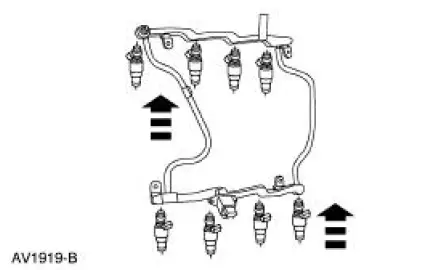Ford Mustang (1999-2004) Service Manual: Fuel Injectors
Removal
WARNING: Do not smoke or carry lighted tobacco or open flame of any type when working on or near any fuel related components. Highly flammable mixtures are always present and may be ignited. Failure to follow these instructions may result in personal injury.
WARNING: Fuel in the fuel system remains under high pressure even when the engine is not running. Before working on or disconnecting any of the fuel lines or fuel system components, the fuel pressure must be relieved. Failure to follow these instructions may result in personal injury.
1. Relieve the fuel pressure. For additional information, refer to Section.
2. Remove the supply manifold. For additional information, refer to Fuel Injection Supply Manifold in this section.
3. Remove the fuel injectors from the supply manifold.

Installation
1. NOTE: Lubricate the new O-rings with Super Premium SAE 10W-30, XO-10W30-DSP or equivalent meeting Ford specification WSS-M2C153-G, to aid installation.
Inspect the two O-rings on each fuel injector. Install new O-rings if necessary.

2. Install the fuel injectors onto the supply manifold.

3. Install the fuel supply manifold.
 Throttle Body
Throttle Body
Removal
WARNING: Do not smoke or carry lighted tobacco or open flame of any
type when
working on or near any fuel related components. Highly flammable mixtures are
always present
and may be ignited. ...
Other materials:
Compressor to Condenser Discharge Line - 4.6L
Material
Item
Specification
PAG Refrigerant Compressor
Oil (R-134a Systems)
F7AZ-19589-DA (Motorcraft YN-
12-C)
WSH-M1C231-
B
Removal and Installation
NOTE: Installation of a new suction accumulator is not required when
repairing the ...
EGR System Components
The EGR system returns a portion of the exhaust gas to the intake manifold to
reduce the combustion
temperature. This results in lower nitrous oxide formation.
The powertrain control module (PCM) controls the EGR vacuum regulator solenoid .
The EG ...
Installation
1. CAUTION: Make sure the hardened washer is installed between the
lower
suspension arm and bushing and the shock absorber. Failure to do so can result
in
damage and failure of the lower suspension arm and bushing.
NOTE: The toe link bolt and nuts are of a ...

